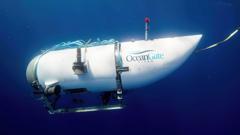PORTLAND, Maine (AP) — Faulty engineering led to the implosion of an experimental submersible that killed five people on the way to the wreck of the Titanic, the National Transportation Safety Board concluded in a report Wednesday.
The NTSB made the statement in its final report on the hull failure and implosion of the Titan submersible in June 2023. Everyone on board the submersible died instantly in the North Atlantic when Titan suffered a catastrophic implosion as it descended to the wreck.
The NTSB report stated that faulty engineering “resulted in the construction of a carbon fiber composite pressure vessel that contained multiple anomalies and failed to meet necessary strength and durability requirements.” It also pointed out that OceanGate, the owner of the Titan, failed to adequately test the submersible and was unaware of its true durability.
Additionally, the report noted that the Titan likely would have been located sooner had OceanGate followed standard emergency response protocols, potentially saving valuable time and resources.
This report complements an earlier Coast Guard findings in August, which termed the Titan implosion as preventable. The Coast Guard also described OceanGate's safety procedures as critically flawed and highlighted discrepancies between their safety protocols and actual practices.
OceanGate has since suspended its operations following the tragic incident. The Titan implosion resulted in the deaths of individuals including OceanGate CEO Stockton Rush, French deep-sea explorer Paul-Henri Nargeolet, British adventurer Hamish Harding, and two Pakistani nationals, Shahzada Dawood and his son Suleman Dawood.
In light of the incident, the NTSB has recommended that the Coast Guard commission a panel of experts to evaluate submersibles and implement regulations based on their findings. The report emphasizes the need for improved safety standards in the growing private exploration industry, which has seen a surge in popularity in recent years.


















